Blue and orange are attention-grabbing colors associated with the sky and the sun and symbolize freedom, joy, and creativity.
That’s why birds that have blue and orange plumage have always been very popular.
Examples of blue and orange birds include the eastern bluebird, western bluebird, blue grosbeak, lazuli bunting, malachite kingfisher, orange-bellied flowerpecker, and many others.
Some of these stunning birds can be seen in the USA, including the eastern bluebird, western bluebird, and the blue grosbeak, among others.
Here are their photos and some fun facts about them.
Table of Contents
Blue And Orange Birds
Western Bluebird

- Scientific Name: Sialia mexicana
- Lifespan: 1-2 years
- Wingspan: 10-13 in
- Color: Bright blue and rust-orange
Western bluebirds are small North American thrushes that love to perch upright and can be identified by their bright blue color, orange breasts and sides, gray bellies, and thin straight bills.
They are common visitors of oak woodlands, mountain conifers, valley farms, and orchards.
To keep competition away and to locate females in the condensed forests, males will often make loud calls that sound like “cheer,” “chur-chur,” and “chup.”
Western bluebirds will often drop suddenly to the ground to catch insects; they are omnivores that also consume some berries.
They look similar to the other two species of bluebirds; the only difference is the throat color.
Western bluebirds have blue (male) or gray (female) throats, eastern bluebirds have orange throats, while mountain bluebirds have no orange color on themselves.
Western bluebirds mate for life. However, one 2003 study discovered that around 45% of western bluebird females had some young in their nests that were not sired by their current mates.
Eastern Bluebird

- Scientific Name: Sialia sialis
- Lifespan: 6-10 years
- Wingspan: 9.8–12.6 in
- Color: Bright blue and brownish-orange
Eastern bluebirds are the smallest bluebird species in the world. They can weigh less than an ounce and have a wingspan of under 10 inches.
These small North American migratory thrushes are easy to spot by their rounded heads, dark eyes, and alert posture.
Male eastern bluebirds have vivid royal blue color above and warm brown-orange and white under. Females are gray above with bluish wings and tails and subdued orange-brown bellies.
They prefer the open country with scattered trees, farms, and roadsides.
Just like their cousins, the mountain bluebirds, the eastern bluebirds are cavity nesters that love nest boxes.
They are very social birds living in flocks with over 100 individuals, but also very territorial during the breeding season. To attract a female, a male bluebird will sing over 1,000 songs per hour; it sings without opening its beak wide.
They have a soft melodious warble song and a liquid and musical “turee” or “queedle” call.
These birds are omnivores that mostly feed on insects, including grasshoppers, crickets, beetles, caterpillars, and some fruit.
Eastern bluebirds are the official birds of Missouri and New York.
The bright blue and orange colors of the males that can be easily spotted on wire or open perches make these small blue birds very popular among birders.
Red-breasted Nuthatch
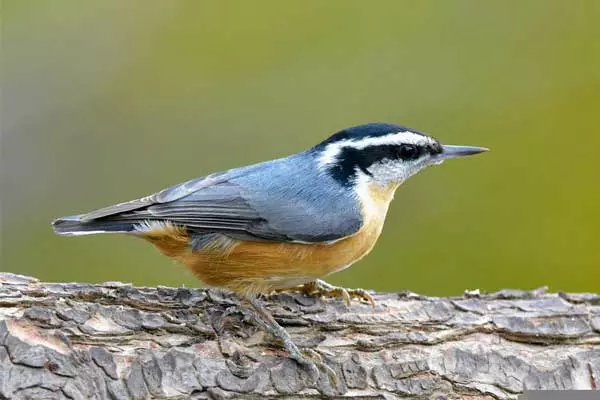
- Scientific Name: Sitta canadensis
- Lifespan: 6 years
- Wingspan: 8.5 in
- Color: Blue-gray and cinnamon-orange
The red-breasted nuthatch is a small songbird with blue-grey upperparts, cinnamon-orange underparts, white throats, and black stripes over the eyes.
It has a straight gray beak, long toes and claws, white supercilium (eyebrow), and a black crown. It can be also recognized by its high-pitched, nasal, and weak “yank-yank” call.
Unlike their cousins, the white-breasted nuthatches who prefer living in deciduous forests, red-breasted nuthatches can be mainly seen in coniferous woods and mountains.
They mainly feed on insects and seeds, especially from conifers.
Red-breasted nuthatches will hoard excess food by wedging nuts into the bark and then hammering them in with their beaks.
Blue Grosbeak
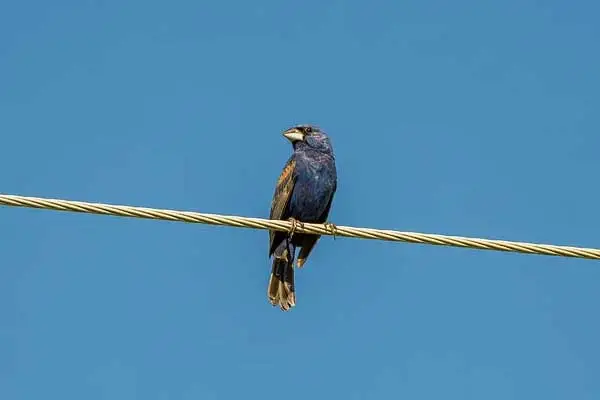
- Scientific Name: Passerina caerulea
- Lifespan: 6-7 years
- Wingspan: 10-11
- Color: Deep blue and orange-brown
Blue grosbeaks are small migratory birds that breed in northern Mexico and the southern US.
These birds are easy to identify by their large, triangular silver beaks that almost cover their entire faces.
One part of their scientific name, the “caerulea,” is a Latin word for “azure-blue”, “sky-blue” or “dark-blue,” which perfectly describes these birds.
Male blue grosbeaks are blue with orange-brown bars on their wings while the females are mostly brown with some scattered blue feathers and two brown wing bars.
They are common in open habitats with scattered trees, riparian woodland, scrub, thickets, cultivated lands, woodland edges, overgrown fields, or hedgerows.
These blue songbirds will occasionally use snake skin when building their nests to scare off predators.
To attract the female, the male will sing, and when a female chooses him as her mate, he will sing louder than before.
Blue grosbeaks are omnivores that often forage on the ground, consuming insects and seeds of weeds, grasses, and other plants.
Read More: List of 15 big blue-colored birds
Blue Rock Thrush

- Scientific Name: Monticola solitarius
- Lifespan: 5-10 years
- Wingspan: 12-14 in
- Color: Blue and dark orange
Blue rock thrushes are unmistakable birds with blue plumage, orange underparts, and dark wings.
They are the national birds of Malta and can be commonly seen in Europe, Africa, and Asia.
Blue rock thrushes are starling-sized birds that can range from 8.3 to 9.1 inches in length and weigh as little as 1.3 oz.
Although named thrush, blue rock thrushes are actually chats.
These tiny blue birds can be seen on mountainsides, sea cliffs, quarries, ruins, and even around towns.
Male blue rock thrushes are blue and orange and have medium-long tails, while the females are much less striking and have dark brown upperparts and paler brown underparts.
They like to nest in rock cavities and walls and usually lay 3-5 eggs.
These birds are omnivores that feed on berries, seeds, snails, insects, locusts, worms, spiders, and even lizards, mice, and snakes.
Read More: 20+ examples of small blue birds
Barn Swallow

- Scientific Name: Hirundo rustica
- Lifespan: 4 years
- Wingspan: 12.5-13.5 in
- Color: Steel blue and rufous-orange
As the most widespread species of swallow in the world, barn swallows’ range covers over 97 million square miles.
They will move from their North American breeding ground around early fall and migrate to Central and South America to winter there.
Common in open areas, parks, and fields, barn swallows will often nest on the eaves of buildings.
Barn swallows are easy to identify by their deep blue heads and wings, rusty-orange throats and foreheads, and pale orange chests and undersides.
They also have long, slender, and deeply forked tails that are a little less prominent in females.
The legend says that barn swallows stole fire from the gods and gave it to people. Gods became so angry that they threw a firebrand at the bird, burning its middle tail feathers.
Barn swallows are one of the largest swallow species found in Maryland and one of many blue birds found in Pennsylvania.
Belted Kingfisher
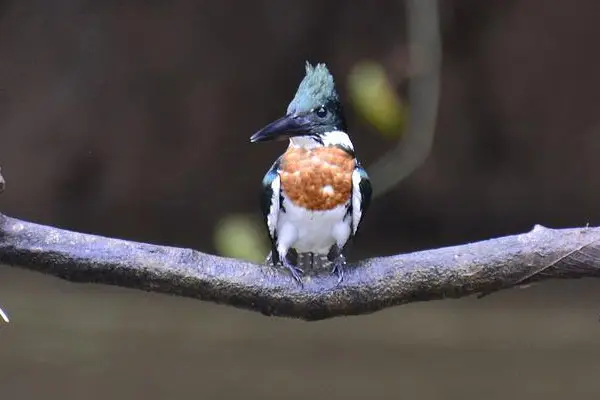
- Scientific Name: Megaceryle alcyon
- Lifespan: 6-14 years
- Wingspan: 19-23 in
- Color: Slate blue, orange, and white
Belted kingfishers are stocky water kingfishers that can be seen across North and Central America and some northern parts of South America.
These large and conspicuous kingfishers have large heads, shaggy crests on the top and back of their heads, and straight, thick, pointed beaks.
Males are slate blue with white underparts. Uncommon for many birds, female belted kingfishers have more bright blue colors with orange patches on the bellies and flanks.
They also have two fused toes which can also help distinguish these blue-winged birds from others.
These birds are common in Southern California and can be very territorial – males will often charge at and chase intruders away.
It is easy to hear before seeing belted kingfishers, they have a distinct and loud rattling or chattering call.
These birds are carnivores that dive to catch fish and crayfish with their heavy beaks; they also feed on mollusks, crustaceans, amphibians, and lizards.
They can’t digest bones, so just like owls, belted kingfishers will regurgitate the undigested pieces as pellets.
Lazuli Bunting

- Scientific Name: Passerina amoena
- Lifespan: 10 years
- Wingspan: 8.7 in
- Color: Bright blue, pumpkin orange, and white
Lazuli buntings are stunning blue and orange North American songbirds that were named after the lapis lazuli gemstone. To honor their beauty, early naturalists named them “Passerina amoena” which means beautiful sparrow.
Males are similar to closely related indigo buntings and have bright blue heads and backs, rusty orange breasts, and white bellies. Females are mostly brown with grayish upperparts.
Lazuli buntings breed in northwestern parts of the United States and migrate south to winter in southeastern Arizona and Mexico.
They are common around brushy areas and occasionally weedy pastures, generally well-watered, and sometimes in towns.
Lazuli buntings are omnivores that forage on the ground and feed on insects and seeds.
Superb Starling
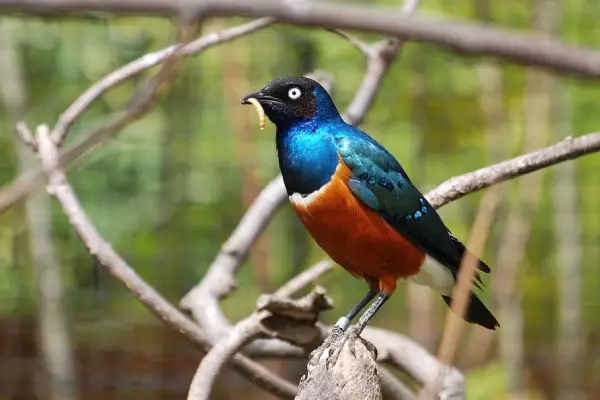
- Scientific Name: Lamprotornis superbus
- Lifespan: up to 10 years in the wild
- Wingspan: n/a
- Color: Black, iridescent blue, and dark orange
Commonly found in East Africa, superb starlings are small birds with black heads, iridescent blue backs, upper breasts, wings, and tails. They have dark orange bellies with a white bar.
They are commonly found in savannas, open woodlands, lakeshore woodlands, gardens, and cultivated fields, at elevations ranging from sea level up to 8,700 ft.
Superb starlings’ long and loud song consists of trills and chatters and their harsh calls can be described as screeching “skreee-cheroo-tchereet.”
These brightly-colored and very gregarious birds are excellent fliers whose wing shapes help them fly swiftly, maneuver quickly, and escape predators with ease.
They are omnivores that mainly consume insects, berries, fruits, and seeds.
Blue-throated Blue flycatcher

- Scientific Name: Cyornis rubeculoides
- Lifespan: n/a
- Wingspan: n/a
- Color: Bright blue, orange, and white
Blue-throated blue flycatchers are beautiful small flycatchers with blue upper plumage, orange chests, and white bellies.
They are common in Asia, on the Indian Subcontinent, in the dense undergrowth of hill forests.
Blue-throated blue flycatchers resemble Tickell’s blue flycatchers – the main difference is the blue throat color that is absent in Tickell’s flycatchers.
These blue and orange birds are usually alone or in pairs and feed on small invertebrates, flies, and larvae.
Tickell’s Blue Flycatcher

- Scientific Name: Cyornis tickelliae
- Lifespan: n/a
- Wingspan: n/a
- Color: Bright blue, orange, and white
Tickell’s blue flycatchers have blue upperparts and orange-and-white underparts, with chests and throats being the most orange. Females are slightly duller blue than males.
These small flycatchers breed in Asia and can be found in open hill forests and forest edges, often near water.
Tickell’s blue flycatchers usually sit upright and forage in the overgrowth. They are carnivores that primarily feed on insects, catching them on the fly.
They have a pleasant high-pitched tinkling song while their calls include dry rattles, churs, and clicks.
Common Kingfisher
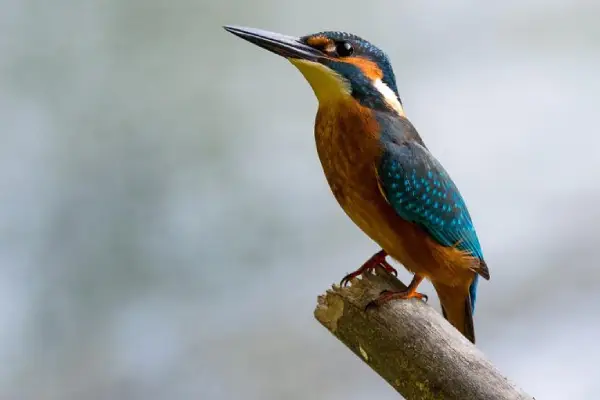
- Scientific Name: Alcedo atthis
- Lifespan: up to 21 years
- Wingspan: 10 in
- Color: Azure blue and orange
Common kingfishers are small kingfishers with azure blue upperparts and orange underparts.
They have long dark beaks, short tails, and large heads.
Common kingfishers are widely distributed across Europe, Asia, and North Africa, and can be seen along rivers, streams, lakes, and ponds – in any habitat that is rich with small fish.
They need to consume over half of their body weight per day and will fly fast, direct, and usually low over the water.
Common kingfishers are carnivores that primarily hunt by diving. They also consume crayfish, frogs, and aquatic insects.
Their special adaptations to the eyes help them see their prey underwater.
There are seven subspecies of common kingfishers, depending on the shade of blue and the intensity of the orange color.
Out of almost 90 species of kingfishers, common kingfishers (also known as the Eurasian kingfishers) are the only ones that breed in Europe.
Rainbow Lorikeet
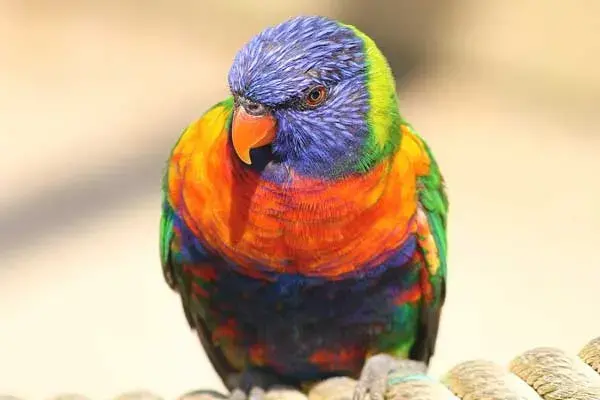
- Scientific Name: Trichoglossus moluccanus
- Lifespan: 20 years
- Wingspan: 7 in
- Color: Green, blue, and orange
Rainbow lorikeets are small brightly colored parrots found in Australia. They have bright yellow-orange breasts, violet-blue heads, and a yellow-green collar.
Adult lorikeets have orange beaks while the juvenile birds hatch with black ones.
These blue and orange parrots can be seen in woodlands, rainforests, and urban areas with many trees.
They are friendly and intelligent birds with an estimated population of over 5 million.
Rainbow lorikeets are omnivores that mostly eat nectar, pollens, fruits, berries, blossoms, and buds. They might eat insects occasionally.
They make excellent pets and are very affectionate, playful, and constantly active.
Rainbow lorikeets got accidentally released in the 1960s in Australia and are now considered pests, out-competing many native birds for food.
Common Chaffinch
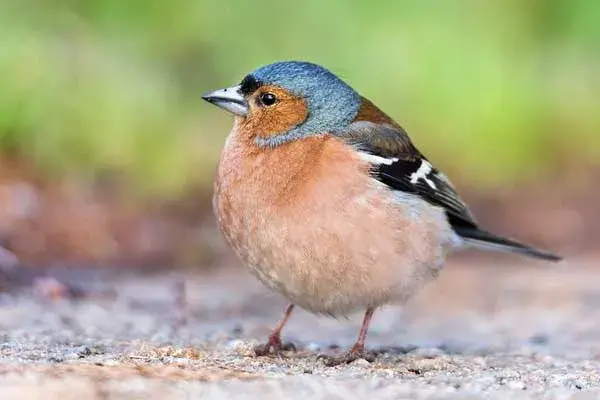
- Scientific Name: Fringilla coelebs
- Lifespan: 3-12 years
- Wingspan: 9.5-11 in
- Color: Blue-gray, rust-orange, and black
Common chaffinches are medium-sized finches that are common around wooded and forested habitats, parks, gardens, and farmlands.
Males are brightly colored and have a blue-gray cap on heads and rust-orange underparts. The females have a much duller plumage color.
The common chaffinch has a range that includes most of Europe, northwest Africa, and northwestern parts of Asia.
It is an omnivore that feeds on insects and seeds.
Today, it is a very popular pet. It was often thought that sightless chaffinches sang best, so some owners deliberately blinded their birds.
Depending on the area they are found, chaffinches will have regional accents with slight differences in their typical songs.
Blue-fronted Redstart

- Scientific Name: Phoenicurus frontalis
- Lifespan: n/a
- Wingspan: n/a
- Color: Ultramarine blue and orange
Blue-fronted redstarts are Old World flycatchers that breed in Asia. They are common around temperate forests.
Males are unmistakable with their ultramarine upperparts and orange breasts, bellies, and tails. Females are brownish-gray and have pale orange tails and lower belies.
Similar to other species of redstarts, blue-fronted redstarts will often perch on visible spots and bob their tails up and down.
They have a song that consists of a series of pleasant warbles and bubbly buzzings.
Blue-fronted redstarts are omnivores that feed on insects, berries, and seeds.
Hildebrandt’s Starling
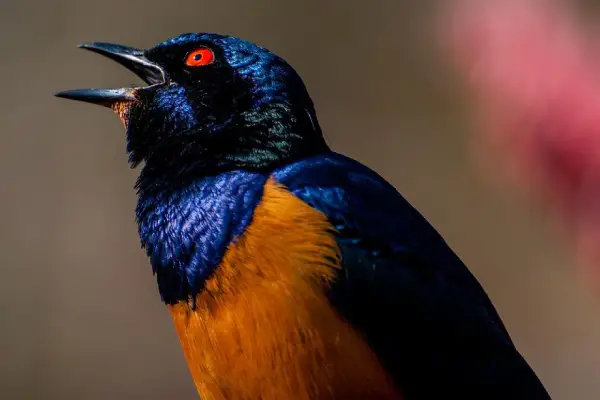
- Scientific Name: Lamprotornis hildebrandti
- Lifespan: up to 16 years
- Wingspan: n/a
- Color: Purple-blue and orange
Hildebrant’s starlings are beautiful starlings with iridescent purple-blue color and orange bellies and underparts. The wings have a slight green sheen, the iris is orange-red, and the beaks and legs are black.
They are commonly found in Africa, in open woodland and open thornbush country of Kenya and Tanzania.
Hildebrandt’s starlings are omnivores that usually forage on the ground, in pairs or in small flocks. They mostly consume insects and some fruit.
These blue and orange birds are cavity nesters, they use abandoned nests of other birds, and are susceptible to brood parasitism.
Some birds, usually the great spotted cuckoo, will invade their nests, throw out starlings’ eggs, and lay their own for starlings to raise.
Blue-eared Kingfisher
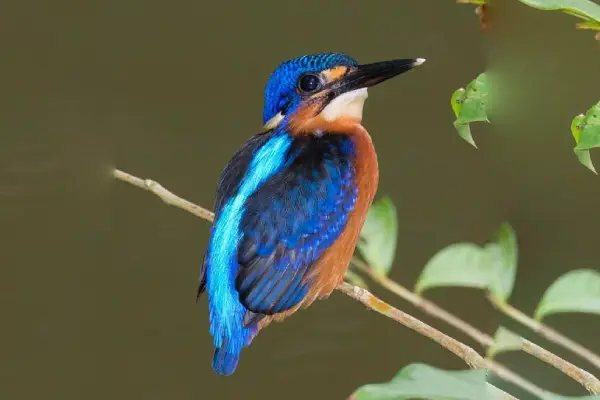
- Scientific Name: Alcedo meninting
- Lifespan: n/a
- Wingspan: n/a
- Color: Cobalt-blue and rich rufous orange
Blue-eared kingfishers are dark blue above and orange below. They have an orange spot in front of the eyes, white ear tufts on the sides of the necks, and long beaks.
Male and female blue-eared kingfishers are differentiated by the beak color: males have all-dark bills while females have a reddish lower mandible.
Blue-eared kingfishers are common in Asia, around densely shaded forests where they hunt in small streams.
They rarely migrate and can be often seen perched high in trees, looking at the water, before diving below to catch some fish, crustaceans, and insects.
Hill Blue Flycatcher
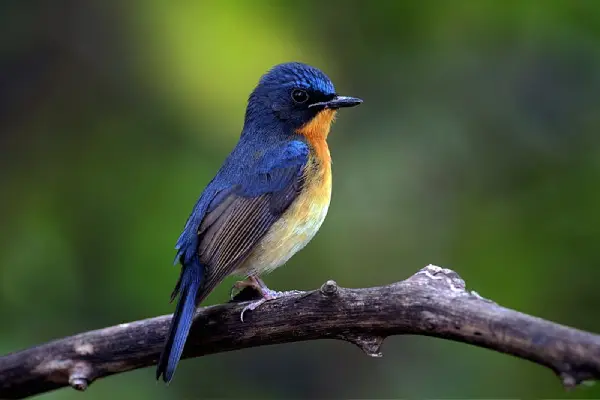
- Scientific Name: Cyornis whitei
- Lifespan: n/a
- Wingspan: n/a
- Color: Deep blue, orange, and white
Commonly found in southern China, northeastern India, and Southeast Asia, the hill blue flycatcher is a beautiful blue and orange bird.
This medium-sized flycatcher has deep blue upperparts, orange throat and breast, and a white belly. Females have slightly duller colors than males.
Hill blue flycatchers live in newly growing broadleaf forests and bamboo thickets and feed on arthropods and other small invertebrates.
Taiwan Vivid Niltava

- Scientific Name: Niltava vivida
- Lifespan: n/a
- Wingspan: n/a
- Color: Deep purple-blue and bright rufous orange
The Taiwan vivid niltava is a medium-sized flycatcher that is endemic to Taiwan in East Asia.
It is also known as small vivid niltava and males have deep purplish-blue heads, backs, and tails with bright rufous orange underparts. Their eyes, legs, beaks, wings, faces, and throats are black.
Females are olive-brown and have greyish-brown crowns and napes.
Taiwan vivid niltavas are common in subtropical or tropical moist montane forests and often forage in middle levels together with other species.
Rufous-bellied Niltava
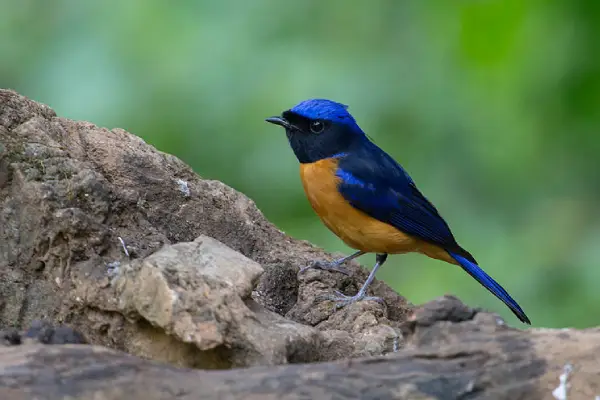
- Scientific Name: Niltava sundara
- Lifespan: n/a
- Wingspan: n/a
- Color: Bright blue and orange
Rufous-bellied niltavas are of the six species of niltava found in China.
These large, stocky, and brightly colored flycatchers are bright blue and have orange bellies. They measure around 6.5 inches in length and weigh only 0.8 oz. They have rounded heads, short tails, and broad beaks.
Rufous-bellied niltavas are common in subtropical or tropical moist lowland forests and subtropical or tropical moist montane forests.
These birds are omnivores and feed on insects, larvae, and some fruits. They tend to spend their time solitary or in pairs.
Eurasian Nuthatch

- Scientific Name: Sitta europaea
- Lifespan: 2 years
- Wingspan: 8.9-10.6 in
- Color: Blue-gray, black, and pale orange
Eurasian nuthatches are small passerine birds with long pointed beaks, short tails, and black masks.
They are permanent residents in Europe and Asia and their habitats include deciduous or mixed woodlands with large, old trees.
Eurasian nuthatches have blue-grey upperparts and orange-red flanks and bellies. They also have dark brown eyes, black eye stripes, and whitish throats.
There are over 20 species of these birds.
Eurasian nuthatches are omnivores that mainly consume insects, particularly caterpillars and beetles, and some nuts and seeds during winter.
They will also store seeds year-round, covering them with lichen, moss, or small pieces of bark.
These birds are monogamous and have a population of 22-57 million individuals.
Malachite Kingfisher
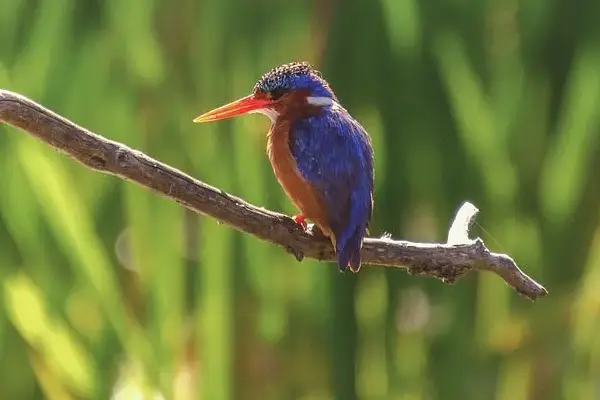
- Scientific Name: Corythornis cristatus
- Lifespan: up to 7 years
- Wingspan: n/a
- Color: Bright metallic blue and rufous orange
Malachite kingfishers are small kingfishers, around 5 inches long. They have bright metallic blue upperparts, rufous orange faces, cheeks, and underparts, and white patches on the throats.
Their legs are bright red, while their beaks are red-orange.
Malachite kingfishers are commonly found near slow-moving waters or ponds, throughout Sub-Saharan Africa.
They will often sit motionless with tails pointed downwards before plunging into the water to snatch prey. Malachite kingfishers mostly feed on fish, aquatic insects, and crustaceans.
They got named from the bright blue feathers on their heads that these blue and orange kingfishers raise as a crest if disturbed.
There are 5 subspecies of malachite kingfishers.
Orange-bellied Flowerpecker

- Scientific Name: Dicaeum trigonostigma
- Lifespan: n/a
- Wingspan: n/a
- Color: Slaty blue and orange
Orange-bellied flowerpeckers are conspicuous birds with slaty blue upperparts and orange underparts. They also have an orange patch on their backs.
Colorful males are hard to miss due to their bright plumage; females are a lot duller.
Orange-bellied flowerpeckers are common in subtropical or tropical moist lowland forests, subtropical or tropical mangrove forests, and subtropical or tropical moist montane forests of Asia.
Further Read: 25+ examples of blue and green birds
Varied Thrush

- Scientific Name: Ixoreus naevius
- Lifespan: 5-6 years
- Wingspan: 13-17 in
- Color: Black, blue-gray, and orange
Common across western North America, varied thrushes are beautiful blue and orange songbirds.
Males have a plumage that is a combination of blue-gray, orange, and black. They also have a black breast band, orange eyebrows, and orange markings on the wings.
Females are similar, but only with a duller pattern.
Varied thrushes are famous for their amazing songs – a series of loud, ringing notes that can be heard in the thick, damp, mossy coniferous forests they inhabit.
They are often very aggressive toward each other, as well as other bird species.
Read More: 15 examples of blue and red birds
Red-flanked Bluetail
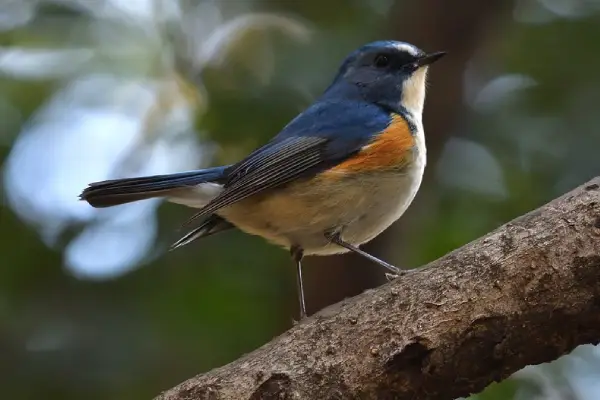
- Scientific Name: Tarsiger cyanurus
- Lifespan: 2-3 years
- Wingspan: 9 in
- Color: Blue and orange-red
Also known as orange-flanked bush-robins, red-flanked bluetails are small blue and orange birds that breed in mixed coniferous forests of Asia and Europe.
Males have a beautiful sky-blue plumage with orange sides and small white eyebrows above the eyes. Females are plain brown and both sexes have small, thin black beaks and slender black legs.
Part of their scientific name, the “cyanurus,” comes from Greek words that mean “dark-blue” and “tail”.
They are similar to common redstarts and will often flick their tails, regularly flying from a perch to catch insects in the air or on the ground.
Read More: 25+ common backyard birds that live in Western Washington
Summary
This concludes our list of blue and orange birds.
Examples include several types of bluebirds, swallows, buntings, parakeets, and many others.
Hopefully next time you see these birds, you will recognize any of them with ease!
And if you enjoyed our article, here are other popular reads on birds: List of black birds with blue heads and List of blue and white birds